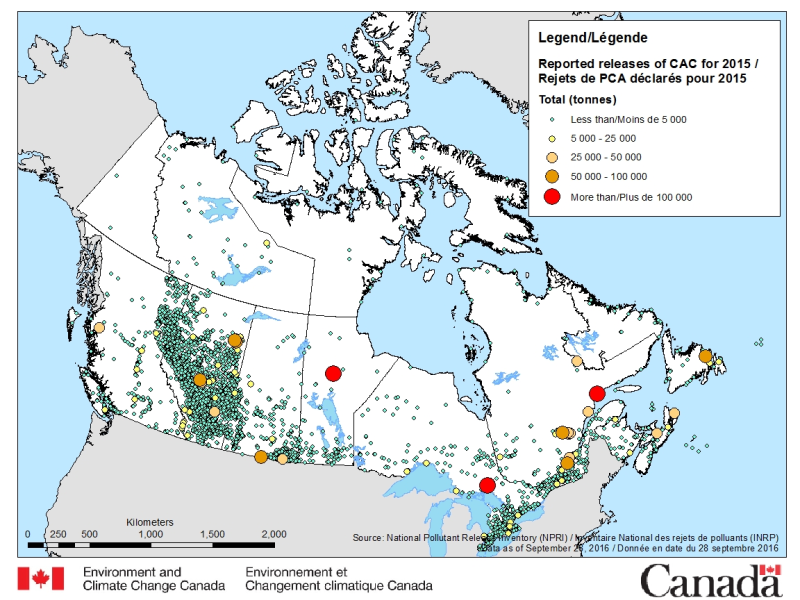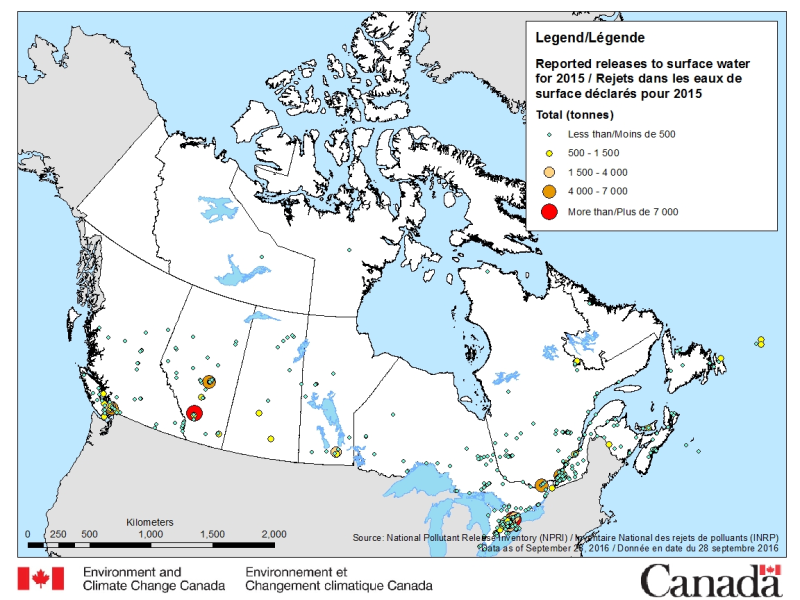CSV
Type of resources
Available actions
Topics
Keywords
Contact for the resource
Provided by
Years
Formats
Representation types
Update frequencies
status
Scale
Resolution
-
The Canadian Environmental Sustainability Indicators (CESI) program provides data and information to track Canada's performance on key environmental sustainability issues. Canada's conserved areas indicators report the amount and proportion of Canada's terrestrial (land and freshwater) and marine area that is recognized as conserved. Well-managed conserved areas are one way to protect wild species and their habitats for present and future generations. Habitat conservation is a measure of human response to the loss of biodiversity and natural habitat. As the area conserved in Canada increases, more lands and waters are withdrawn from direct human development stresses, thereby contributing to biodiversity conservation and improving the health of ecosystems. In turn, healthy ecosystems provide benefits such as clean water, mitigation of climate change, pollination and improved human health. Information is provided to Canadians in a number of formats including: static and interactive maps, charts and graphs, HTML and CSV data tables and downloadable reports. See the supplementary documentation for the data sources and details on how the data were collected and how the indicator was calculated. Canadian Environmental Sustainability Indicators: https://www.canada.ca/environmental-indicators
-
PURPOSE: To record hourly water temperatures throughout the Margaree watershed. DESCRIPTION: The Department of Fisheries and Oceans (DFO) has been deploying water temperature monitoring equipment since spring 1993 in the Margaree River watershed. Coverage has changed throughout the time series and there is little documentation regarding equipment used. In recent years data have been collected using VEMCOs. USE LIMITATION: To ensure scientific integrity and appropriate use of the data, we would encourage you to contact the data custodian.
-
The Biodiversity Science Database is a compilation of fish community data from DFO Science Surveys. Data includes: sampling site, date, fish counts, fish species, and associated habitat information.
-

PURPOSE: These data have been updated following a Canadian Science Advice Secretariat (CSAS) Regional Science Advisory Process. Associated publications are available in the citation section below or will be posted on the Fisheries and Oceans Canada (DFO) Science Advisory Schedule as they become available. DESCRIPTION: Provide a record of commercial and mature female snow crab abundance and biomass in the southern Gulf of St. Lawrence. Female snow crab represents an index of reproductive stock. Snow crab in the southern Gulf are treated as a single stock in the annual assessments. Abundance and biomass estimates for the commercial and female reproductive stock are produced using kriging, a type of spatial analysis. The time series starts in 1997. USE LIMITATION: To ensure scientific integrity and appropriate use of the data, we would encourage you to contact the data custodian.
-

Commercial and exploratory fisheries for Arctic Char, Salvelinus alpinus, provide significant economic opportunities for Nunavummiut in several Nunavut communities. Having an accurate understanding of the weight of the Arctic Char that are harvested is important for tracking harvest and for understanding how biological parameters may be changing over time as a result of exploitation and/or climactic and environmental changes. Unfortunately, most fish enter the processing plants as dressed (gills and viscera removed) and therefore conversion factors have to be applied to reconcile whole (round) weight from dressed weight. Here, we provide an updated conversion factor based on linear regression for Arctic Char from the Halokvik River (locally known as 30 Mile) near the community of Cambridge Bay. This conversion factor can be used moving forward as the Halokvik River continues to be commercially harvested.
-

Summary The Quebec region of the Department of Fisheries and Oceans (DFO) is responsible for the assessment of several fish and invertebrate stocks exploited in the Estuary and the northern Gulf of St. Lawrence. The commercial catches sampling program is one of the sources of information used to complete these assessments. The data collected by this program, at wharf or at sea, offers among other things the advantage of a relatively large spatio-temporal coverage and provides some of the necessary knowledge to assess the demography and the structure of the exploited populations. This program is implemented by specialized DFO staff whose main mandate is to collect biological data on groundfish, pelagic fish and marine invertebrate species that are commercially exploited in the various marine communities. Data This dataset on the common softshell clam (Mya arenaria) includes the metadata, sample weight, the shell width and the number of specimens measured. This dataset covers the periods of 1994 and 2004-2010. In order to protect the confidentiality of the sources, some informations (such as those concerning the vessel) have been excluded and others (such as the date of capture) have been simplified. Entries where there was only one vessel in a fishing area for a given year were also excluded. Further information including the fishing areas coordinates can be found by clicking on the «Atlantic and Arctic commercial fisheries» and «Fishing areas» links below.
-

The National Pollutant Release Inventory (NPRI) is Canada's public inventory of pollutant releases (to air, water and land), disposals and transfers for recycling. The files below contain a map of Canada showing the locations of all facilities that reported direct releases of Criteria Air Contaminants to the NPRI. The data are for the most recent reporting year, by reported total quantities of these releases. The map is available in both ESRI REST (to use with ARC GIS) and WMS (open source) formats. For more information about the individual reporting facilities, a dataset is available in a CSV format. Please consult the following resources to enhance your analysis: - Guide on using and Interpreting NPRI Data: https://www.canada.ca/en/environment-climate-change/services/national-pollutant-release-inventory/using-interpreting-data.html - Access additional data from the NPRI, including datasets and mapping products: https://www.canada.ca/en/environment-climate-change/services/national-pollutant-release-inventory/tools-resources-data/exploredata.html
-

PURPOSE: Support age-structured population stock assessments and research on fish growth. DESCRIPTION: Fish otoliths are collected from scientific surveys, fisheries observers on fishing vessels and from scientific sampling of commercial fisheries. The otoliths collected are placed in paper envelopes, recorded and held in a climate-controlled storage facility. Age determination is performed yearly on available samples. Digital images of each pair of otoliths collected are captured when possible. The information made available through this metadata record is the summary of otoliths present in the collection at the Gulf Fisheries Centre in Moncton, NB, Canada. The number of otoliths available from different sources by year and month is provided for the following stocks: - Atlantic Cod NAFO Divisions 4T / 4VN (Nov. to Apr.) - White Hake NAFO Division 4T - American Plaice NAFO Division 4T - Winter Flounder NAFO Division 4T - Yellowtail Flounder NAFO Division 4T - Witch Flounder NAFO Divisions 4RST - Skate species NAFO Division 4T There is additional information of observed sex, length, weight and age information of fish specimens made by trained Fisheries and Oceans Canada technicians that can be made available upon request. PARAMETERS COLLECTED: length (biological), age (biological) NOTES ON QUALITY CONTROL: Reference collections for certain species exist and are used to train technicians and to calibrate the age readings obtained by the fisheries technicians that use the otoliths for age estimation. Digital images of the otoliths that are part of the reference collection are available and used for calibration and training purposes. The otolith images are also authoritatively annotated by fisheries technicians. PHYSICAL SAMPLE DETAILS: Fish otoliths, skate vertebrae SAMPLING METHODS: Marine fish otoliths are obtained from fish specimens collected during research surveys and during scientific sampling of commercial fisheries. The sagittal otoliths are removed from sampled specimens, recorded, placed in a protective medium and held in a climate-controlled storage facility. Digital images of each pair of otoliths collected are captured when possible. USE LIMITATION: To ensure scientific integrity and appropriate use of the data, we would encourage you to contact the data custodian.
-

Summary The Quebec region of the Department of Fisheries and Oceans (DFO) is responsible for the assessment of several fish and invertebrate stocks exploited in the Estuary and the northern Gulf of St. Lawrence. The commercial catches sampling program is one of the sources of information used to complete these assessments. The data collected by this program, at wharf or at sea, offers among other things the advantage of a relatively large spatio-temporal coverage and provides some of the necessary knowledge to assess the demography and the structure of the exploited populations. This program is implemented by specialized DFO staff whose main mandate is to collect biological data on groundfish, pelagic fish and marine invertebrate species that are commercially exploited in the various marine communities. Data This dataset on Greenland halibut (Reinhardtius hippoglossoides) includes the metadata, sample weight, fish length, the sex and the number of specimens measured. This dataset covers the period of 1987 to present. In order to protect the confidentiality of the sources, some informations (such as those concerning the vessel) have been excluded and others (such as the date of capture) have been simplified. Entries where there was only one vessel in a fishing area for a given year were also excluded. Further information including the fishing areas coordinates can be found by clicking on the «Atlantic and Arctic commercial fisheries» and «Fishing areas» links below.
-

The National Pollutant Release Inventory (NPRI) is Canada's public inventory of pollutant releases (to air, water and land), disposals and transfers for recycling. The files below contain a map of Canada showing the locations of all facilities that reported direct releases to surface waters to the NPRI. The data are for the most recent reporting year, by reported total quantities of these releases. The map is available in both ESRI REST (to use with ARC GIS) and WMS (open source) formats. For more information about the individual reporting facilities, a dataset is available in a CSV format. Please consult the following resources to enhance your analysis: - Guide on using and Interpreting NPRI Data: https://www.canada.ca/en/environment-climate-change/services/national-pollutant-release-inventory/using-interpreting-data.html - Access additional data from the NPRI, including datasets and mapping products: https://www.canada.ca/en/environment-climate-change/services/national-pollutant-release-inventory/tools-resources-data/exploredata.html
 Arctic SDI catalogue
Arctic SDI catalogue